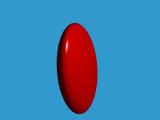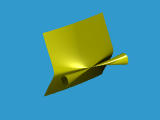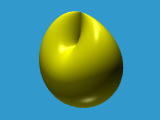

Algebraic surfaces are surfaces whose points (x,y,z) satisfy a polynomial of three variables p(x,y,z)=0. For example, a sphere is an algebraic surface since it can be described as
(x - a)2 + (y - b)2 + (z - c)2 = r2The degree of an algebraic surface is the highest degree of all of its terms. Thus, spheres are degree two algebraic surfaces. It is very difficult to display algebraic surfaces correctly because some of them may extend to infinity and some of them are extremely complicated.
POVRAY can raytrace any algebraic surface of degree less than or equal to 7. In general, this range is sufficient for most applications because algebraic surfaces of degree higher than 7 are rarely used and are very complex. POVRAY supports two forms. One for quadric, cubic and quartic surfaces which are commonly used. The other is a general form.

quadric {
< A, B, C >,
< D, E, F >,
< G, H, I >,
J
// pigment and finish
}
where these ten values are coefficients of a quadric polynomial as
follows:
Ax2 + By2 + Cz2 + Dxy + Exz + Fyz + Gx + Hy + Iz + J = 0For example, to trace the following quadric surface
10x2 + y2 + 2z2 + 3xy + 4xz + yz + 5x + y + 10z = 0use the following
quadric {
< 10, 1, 2 >,
< 3, 4, 1 >,
< 5, 1, 10 >,
0
// pigment, finish and transformations
}
Note that in general geometric transformations are required to bring the
surface into your camera's coverage. Also note that the above equation is
different from what has been discussed in class.
The result a flat ellipsoid as shown below:

Click here to download the scene file.

A1x3 + A2x2y + A3x2z + A4x2 + A5xy2 + A6xyz + A7xy + A8xz2 + A9xz + A10x + A11y3 + A12y2z + A13y2 + A14yz2 + A15yz + A16y + A17z3 + A18z2 + A19z + A20 = 0There are 20 coefficients organized as follows:
cubic {
< A1, A2, A3, ...., A20 >
sturm // optional
// pigment, finish and transformations
}
All 20 coefficients are in a single vector. Note that a new
keyword sturm is introduced. This keyword is used only when the
degree of an algebraic surface is greater than 2. The purpose of using this
keyword is for more accurate ray and object intersection. As a result,
it is more time consuming than without using it. Charles Sturm was a
well-known German mathematician of the last century who discovered a method
for determining the ranges of the roots of a single-variable polynomial.
To trace the following cubic surface
x3 - 0.11111xz2 + y2 = 0use the following:
cubic {
// x3 x2y x2z x2 xy2
< 1, 0, 0, 0, 0,
// xyz xy xz2 xz x
0, 0, -0.11111, 0, 0,
// y3 y2z y2 yz2 yz
0, 0, 1, 0, 0,
// y z3 z2 z Const
0, 0, 0, 0, 0 >
sturm
clipped_by {
box { < -2, -2, -2 >, < 2, 2, 2 > }
}
}
Because cubic surfaces extend to infinity, frequently a clipped_by {} is used to cut off unwanted part. It may require several tries to get the result right. Here is the result:

Click here to download this scene file.

A1x4 + A2x3y + A3x3z + A4x3 + A5x2y2 + A6x2yz + A7x2y + A8x2z2 + A9x2z + A10x2 + A11xy3 + A12xy2z + A13xy2 + A14xyz2 + A15xyz + A16xy + A17xz3 + A18xz2 + A19xz + A20x + A21y4 + A22y3z + A23y3 + A24y2z2 + A25y2z + A26y2 + A27yz3 + A28yz2 + A29yz + A30y + A31z4 + A32z3 + A33z2 + A34z + A35 = 0
These coefficients are organized as follows:
quartic {
< A1, A2, ...., A35 >
sturm // optional
// pigment, finish and transformations
}
To trace the following quartic surface
x4 + x2y2 - 3x2y + 2.5x2z2 + 1.5y2z2 - 3yz2 + 1.5z4 = 0use the following
quartic {
// x^4 x^3y x^3z x^3 x^2y^2
< 1, 0, 0, 0, 1,
// x^2yz x^2y x^2z^2 x^2z x^2
0, -3, 2.5, 0, 0,
// xy^3 xy^2z xy^2 xyz^2 xyz
0, 0, 0, 0, 0,
// xy xz^3 xz^2 xz x
0, 0, 0, 0, 0,
// y^4 y^3z y^3 y^2z^2 y^2z
0, 0, 0, 1.5, 0,
// y^2 yz^3 yz^2 yz y
0, 0, -3, 0, 0
// z^4 z^3 z^2 z Const
1.5, 0, 0, 0, 0 >
sturm
// pigment, finish and transformations
}
The result is the following well-known cross-cup surface

Click here to download the scene file.

poly {
n, // degree of the surface
< A1, A2, ..... > // coefficients
sturm // optional
// pigment, finish and transformations
}
where the degree n can be an integer in the range 2 and 7.
The correspondence between coefficients and their positions in the vector
is quite tedious and will not be listed here. If you need it, please click
here to download a PostScript format table.